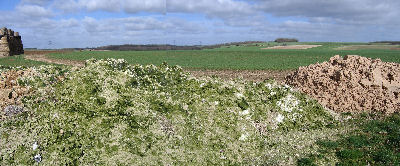These pages are in memory of my Grandfather, Rifleman 425910 Sydney William Loxton, and the other 300+ Officers
and Men
|
||
© Open a Medium-Resolution, Half-Screen Version in a New Window |
 |
§ Open a Medium-Resolution, Full-Size Version in a New Window |
Photo taken on 1st March 2008 from 02° 25' 28"E, 49° 59' 33"N on the Beaucourt to Mirvaux road, showing the view
from the North to the East-North-East.
|
||
July was spent relatively quietly, apart from one major incident in the trenches at Mirvaux. This involved a daylight trench raid carried out by the Battalion on 25 July. No less than three hundred PORs went over the top, and initially it progressed well with the German trenches being entered, prisoners taken and casualties inflicted. Unfortunately the smokescreen which was to cover the withdrawal did not materialise. The raiders were taken in the flanks by heavy machine gun fire, which resulted in two officers killed, four wounded and 113 other rank casualties. Many of the wounded had to be left behind in No Man's Land. A member of the Great War Forum reminisces about her own Grandfather, Rfn Algar H Francis, who was also injured in this raid. London Rifle Brigade (5th City of London Regt), Any Info He was badly wounded on the 25th July 1918 whilst serving with the Post Office Rifles, and left in "No Man's Land". I seem to remember Grandad saying before the raid, which took place at 10.00 hours on the morning of the 25th, they had been at a place called "Daily Mail Wood". The Trench Map of this area for the 24th July shows Daily Mail Wood A and B well to the east of Mirvaux, and approximately half way towards the town of Contay. As the Trench Map suggests the enemy held Contay, and the raid might well have been to attack the trenches to the west of the town, it is reasonable to assume the writer of the Battalion's War Diary would have used the name of the village in Allied hands and where the Battalion had been based for a few weeks, rather than the name of the nearer, yet enemy-held town to describe the location. |
||
© Open a Medium-Resolution, Half-Screen Version in a New Window |
 |
§ Open a Medium-Resolution, Full-Size Version in a New Window |
It is also possible that, rather than attack the enemy trenches due east of Contay from Summit Wood, across
over 1,000 yards of open and, nearer to the enemy, flat country, the men might have moved up the trench snaking north-east
from Summit Wood and attacked the enemy positions north-west of Contay down 600 yards of gentle slope. Charles Messenger goes on to quote an eye-witness. I saw heroism that day. 'Old' Joe Bagnal of Manchester, a stretcher bearer, who went out three times under fire to fetch someone to safety. To collect our men in No Man's Land our MO and Padre went out towards the German Line displaying a Red Cross flag - they successfully negotiated for a cease fire for one hour with the German commander. Then all hell let loose on our front line and supports, while the sixty prisoners were being interrogated. The Toll Twenty POR All Ranks were killed in action on 25th July 1918. From 25th July to 1st August inclusive a further eight All Ranks died from their wounds. It is by no means certain that all these wounds were sustained in this major raid, but whichever way it is viewed, 25th July 1918 was a particularly bloody day for the battalion. In MemoriamReaders wishing to see the countryside and modern maps are advised to use the excellent site http://www.geoportail.fr Although in French, this site provides better quality images for this area of France than Google Earth, and the map overlays are superb. Under "ALLER À" (Go To), "Entrer une commune" (Enter a town), and click on "J'y vais" (Go there). On the left-hand menu, under "MA SÉLECTION", click on the + sign alongside "CARTES" (Maps) and select "CARTE IGN". This will add a Maps slider bar to the "MA VISUALISATION" section above, allowing you to set the opacity of the maps and the aerial photos as you wish. All the other controls are by and large self-explanatory icons.On my visit to France on 1st March 2008 I took a large number of photos. Look at my Gallery page to see views of Mirvaux village and the surrounding countryside, as well as other pictures relating to 25th July 1918 and my Grandfather's evacuation from the battle. At the time of my visit I had not yet obtained the Trench Map of the Mirvaux area, so having studied the pictures on www.geoportail.fr, I photographed what I thought might be likely sites. It is by pure coincidence that I took photos of Daily Mail Wood, and by lack of information that I didn't get to Summit Wood or the No Man's Land beyond. Sounds like a good excuse for a return visit! |
||
|
||